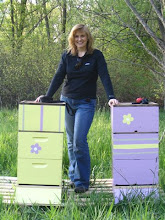
I'm starting an apiary for a community garden. I say remnants because my father kept bees and like all his tools, anything he owned, he discarded without regard for posterity.
My father dropped things where his mind became bored. His fingers released the level or the hammer, letting it fall to the ground because he saw a piece of plastic in the distance that interested him more. He threw empty paint cans, carburetors, lawnmower engines, water heaters, scrap metal into the forest. Scattered them like seeds.
I found stacks of bee boxes near the pond--all rotted. At one hundred dollars a box, not including frames, about 2,000 dollars worth of equipment discarded. Found some boxes beneath fir trees, stuck together with resin and pine needles. Out of the 35 hives I managed to piece together 2 hives with frames. I had to climb up a pyramid of wood and metal in an old shack, nestled in the forest, to find the queen excluder, which lay dusty and gummed with beeswax on a top rafter.
When I return to the property (rarely now), I'm angry at my father's legacy. He was careless with his life and careless with his relationships. He was a destructive narcissist-- a terrible personality disorder: destructive to spouse, children, even the land. I feel compelled to write a novel about growing up with such a parent so that I can save some future boy or girl from this King Lear.
But I don't know if I will because I'm with Virginia Woolf on this one: Rage can deform and twist books. That's what she thought of Charlotte Bronte's writing, a writer who "had more genius in her than Jane Austen." But Jane Austen was brilliant says Woolf because "Here was a woman about the year 18oo writing without hate, without bitterness, without fear, without protest, without preaching. That was how Shakespeare wrote..." (1)
So no bitterness, no preaching. And I'm one who likes a bit of comedy with my tragedy. It's hard to find some comedy in this narcissist's tale. There's a reason King Lear is called a tragedy. It's a heavy burden, like the actual experience and who wants to relive that.
I have to clean and sterilize the bee boxes. It will be a relief to handle the bees myself, no frenetic King around fueling the rage of the Queen bee and her colony.



